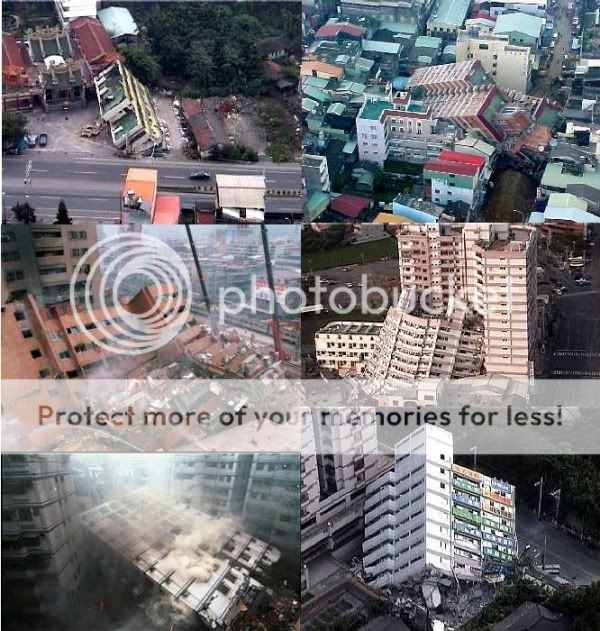It looks like you're using an Ad Blocker.
Please white-list or disable AboveTopSecret.com in your ad-blocking tool.
Thank you.
Some features of ATS will be disabled while you continue to use an ad-blocker.
share:
I don't think I've seen this image in any of these threads before. And shows how the building was constructed.
WTC construction
[edit on 10-11-2008 by grey580]
WTC construction
[edit on 10-11-2008 by grey580]
the first video is blatantly edited. Thanks for attempting to spread dis info!
In what way is it edited??
If you are referring to the close up which then pans outwards.....and thats what i presume, how can that be construed as spreading disinfo....
Or perhaps i am missing your point...
Care to elaborate...??
If you are referring to the close up which then pans outwards.....and thats what i presume, how can that be construed as spreading disinfo....
Or perhaps i am missing your point...
Care to elaborate...??
Originally posted by Seymour Butz
Translation:
Oops, I know that the code is for building design, and that in order to "comply", the structural docs would have to be released, something that NIST is legally prevented to do due to privacy laws.
And.... building design and collapse modelling are 2 different things, and so maybe if I bluff enough, I might be able to convince my fellow conspiracy minded users of this website. Too bad it won't hold water in the real world though. In the real world, as opposed to Twoofaloon world, I must prove my points, something I can't do....
The ICC Performance Code® for Buildings and Facilities clearly defines the objectives for achieving the intended levels of occupant
safety, property protection and community welfare. The code provides a framework to achieve the defined objectives in terms
of tolerable levels of damage and magnitudes of design events, such as fire and natural hazards.
Now, if you believe this doesn't encompass modeling a building's performance during a fire, then can you suggest one that better fits?
Originally posted by Griff
Now, if you believe this doesn't encompass modeling a building's performance during a fire, then can you suggest one that better fits?
Griff, what exactly is the point you're trying to make here? You started a thread claiming that NIST were required to follow the ICC codes used when constructing a building, but you never provided any justification for this other than your own opinion.
Do you have any evidence whatsoever that NIST has any requirement to follow these codes or are you just trying to cast doubt onto the NIST report by speculating wildly?
Lets not forget of course that NIST has released their SAP2000 model which includes the weights and details of the structure. It seems you are simply trying to poke holes in the "official story" rather than proving any sort of alternate hypothesis.
So when are the Patriots going to put the rope around Sunder's neck? Perhaps the Patriots offer him the firing squad. And being NY, there is always
the electric chair.
For the thirty pieces of silver Sunder got, my bet is he gets the rope.
For the thirty pieces of silver Sunder got, my bet is he gets the rope.
Shouldn't the point of any serious research be to find out what happened?
Trying to make the truth fit your point of view is not the way to go.
when trying to find out what happened we should be throwing away our idea of what happened. we should focus on the evidence at hand.
the towers IMO fell because of the planes hitting them. that's what I see when i look at the video the op posted.
wtc 7, don't know what happened there. That looks a little funny to me.
Trying to make the truth fit your point of view is not the way to go.
when trying to find out what happened we should be throwing away our idea of what happened. we should focus on the evidence at hand.
the towers IMO fell because of the planes hitting them. that's what I see when i look at the video the op posted.
wtc 7, don't know what happened there. That looks a little funny to me.
Originally posted by exponent
You started a thread claiming that NIST were required to follow the ICC codes used when constructing a building, but you never provided any justification for this other than your own opinion.
No. My opinion is that NIST should have no governance over codes that they fail to follow themselves.
Do you have any evidence whatsoever that NIST has any requirement to follow these codes or are you just trying to cast doubt onto the NIST report by speculating wildly?
The National Institute of Standards and Technology (NIST) and the International Code Council (ICC), and their predecessor organizations, have a rich and sustained history of cooperation and partnership that builds on our deep and shared dedication to building safety and fire prevention. Many of you probably know of, or have worked with, my predecessors—Dick Wright, Jack Snell, and Jim Hill. At the request of NIST Director Bill Jeffrey, Jim Hill is now serving as acting deputy director for all of NIST.
S. Shyam Sunder, Acting Director, BFRL, NIST
ICC Annual Banquet
September 20, 2006
Lets not forget of course that NIST has released their SAP2000 model which includes the weights and details of the structure. It seems you are simply trying to poke holes in the "official story" rather than proving any sort of alternate hypothesis.
This appendix gives guidance regarding qualifications and information that should be provided when undertaking computer modeling.
More specifically, the appendix requests that computer program data be submitted as part of the documentation. Also, limitations
and applicability of the model must be included as part of the documentation. Finally, the scenarios used to run the particular
model must be justified.
Can you show me where NIST included their limitations of their model as part of their report? I must have missed that part.
BTW, I never claimed to be an expert on these codes. Hence why I keep asking if there is another code that would be more suitable to compare with. But, all I have recieved in return is being called "stupid".
[edit on 11/10/2008 by Griff]
[edit on 11/10/2008 by Griff]
Originally posted by grey580
wtc 7, don't know what happened there. That looks a little funny to me.
Exactly why my focus has been WTC 7. I have my doubts that the towers fell just from plane damage and fire alone, but that is harder to establish as fact than the obvious demolition of WTC 7 IMO.
reply to post by Griff
BTW, I'm not the only one who has concerns about these new code changes.
www.buildings.com...
But, we are getting way off topic in this thread. I am adding this post to the thread I made. If you would like to comment, comment over there.
BTW, I'm not the only one who has concerns about these new code changes.
BOMA, other representatives of the commercial real estate industry, and many code and safety experts opposed these code changes. BOMA argued that the need for an additional stairway in particular was not demonstrated by NIST and other proponents, and, given current fire statistics, is not well founded. A full cost/benefit analysis necessary to document the societal impact of these sweeping changes was not performed as part of the NIST study, as was repeatedly urged by BOMA and many other groups. This change was also opposed by the ICC technical committees with oversight of egress requirements in the ICC codes. Building construction experts noted during the ICC public hearings that proponents for this change did not demonstrate the need for the stairwell in actually contributing to the safe evacuation of a building - a particular concern in view of comments by the fire service during the hearings.
www.buildings.com...
But, we are getting way off topic in this thread. I am adding this post to the thread I made. If you would like to comment, comment over there.
Originally posted by benoni
In what way is it edited??
If you are referring to the close up which then pans outwards.....and thats what i presume, how can that be construed as spreading disinfo....
Or perhaps i am missing your point...
Care to elaborate...??
no, the original video, that i have seen, distinctly shows small explosions (ejections) out of the windows below the debris as the building is collapsing. Because these explosions have been removed, this edited video, is not congruent with all of the other un-doctored recordings of this collapse. If you extract the video from youtube and inspect it with any high quality video program, the loss of pixels due to editing, and the impossible physics of the "smoke" in the area i'm describing is clearly visible.
Although i doubt it, this could be attributed to poor rendering quality, but the explosions clearly visible in the original video have been severely dampened . . .
i'm looking for the original video, when i find it, i will post it ASAP
edited: "video" found
this is not the exact video i was looking for, but it gets the job done . . .
[edit on 11/10/2008 by JPhish]
Originally posted by Griff
No. My opinion is that NIST should have no governance over codes that they fail to follow themselves.
You have not shown that NIST is required to adhere to these codes in any manner.
Can you show me where NIST included their limitations of their model as part of their report? I must have missed that part.
It depends in what context you use "limitations", there's plenty of discussion of accuracy, sensitivity and limitations on software analysis, but lets not forget NIST is not constructing a building, they are attempting to model the processes involved in an already constructed building.
BTW, I never claimed to be an expert on these codes. Hence why I keep asking if there is another code that would be more suitable to compare with. But, all I have recieved in return is being called "stupid".
Because you are not asking the people who you should be asking. You are asking (and by asking I mean you are making claims) a crowd of people who are already quite convinced that NIST is complicit in some sort of coverup. Very few people here have any experience with building code, do you really expect to get a good answer here or are you just trying to discredit NIST?
jphish..
OK...not quite sure what you mean buddy, but we are focussed here on 2 new pieces of footage....and clearly they are genuine....
No disinfo footage...watch again...
OK...not quite sure what you mean buddy, but we are focussed here on 2 new pieces of footage....and clearly they are genuine....
No disinfo footage...watch again...
posted by benoni
In what way is it edited??
If you are referring to the close up which then pans outwards.....and thats what i presume, how can that be construed as spreading disinfo....
Or perhaps i am missing your point...
Care to elaborate...??
Originally posted by JPhish
no, the original video, that i have seen, distinctly shows small explosions (ejections) out of the windows below the debris as the building is collapsing. Because these explosions have been removed, this edited video, is not congruent with all of the other un-doctored recordings of this collapse. If you extract the video from youtube and inspect it with any high quality video program, the loss of pixels due to editing, and the impossible physics of the "smoke" in the area i'm describing is clearly visible.
Although i doubt it, this could be attributed to poor rendering quality, but the explosions clearly visible in the original video have been severely dampened . . .
i'm looking for the original video, when i find it, i will post it ASAP
edited: "video" found
this is not the exact video i was looking for, but it gets the job done . . .
Did you download the higher quality wmv (s) available from the top right of the YouTube page? The explosions are still there in the 2008 leaked version; but are much clearer in your much closer video. - YouTube version
Those are massive explosions which are preceding the 'collapse' by at least 6-10 floors. You can also clearly see the huge exterior 4-ton wall sections being blasted up and out and down onto the neighboring buildings; including Winter Garden and WFC3.
New collapse footage of WTC7 and North Tower - Nov 2008
8000 pound exterior wall sections exploded 600 feet away from WTC1
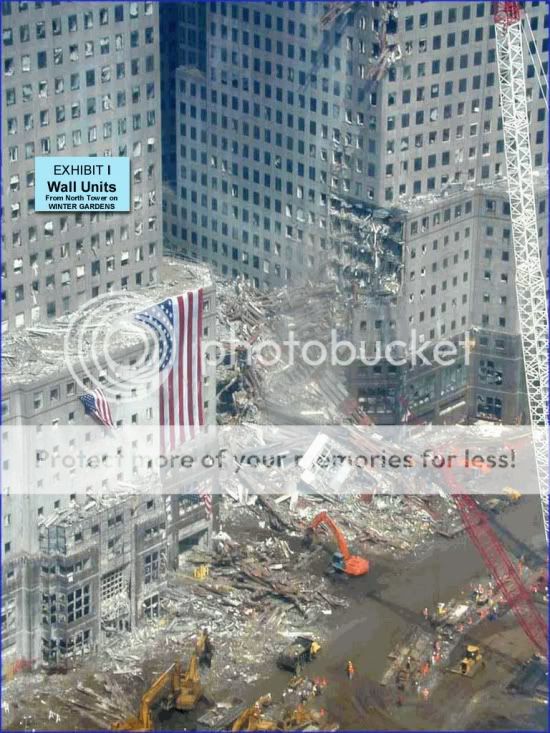
Huge multi-section exterior wall exploded 600 feet away from WTC1
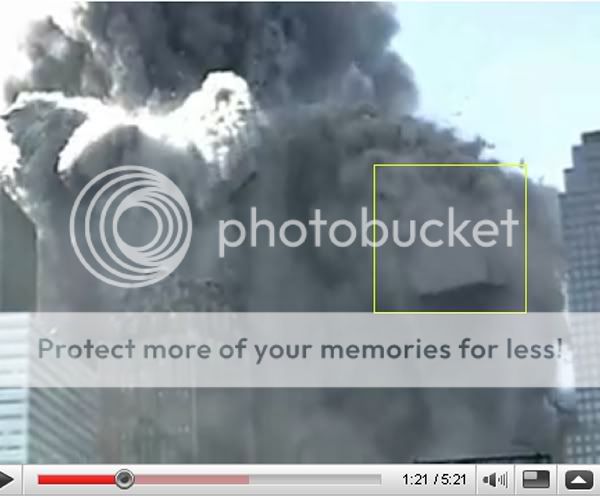
Originally posted by SPreston
Those are massive explosions which are preceding the 'collapse' by at least 6-10 floors. You can also clearly see the huge exterior 4-ton wall sections being blasted up and out and down onto the neighboring buildings; including Winter Garden and WFC3.
Why and how would explosions possibly push external sections upwards? Can you suggest some mechanism or reason? In fact why would they even push the columns outwards in such a violent manner? You are aware that demolition explosives cut columns, rather than displacing them like this?
You seem to be proposing some bizarre theory that would indicate every wall of every floor of the WTC was absolutely packed with high explosive, yet we have no evidence of high explosive detonations at the WTC? How can these explosions be both powerful enough to accelerate gigantic amounts of mass to significant speeds, yet be indistinguishable from the roar of collapse?
Originally posted by exponent
You have not shown that NIST is required to adhere to these codes in any manner.
In contrast, structural design practice in civil engineering is characterized by: (1) its governance by codes of practice, which are an integral part of the system of federal, state and local laws in the United States; (2) its concern with demands placed on a facility by the natural environment as well as by facility operation; (3) its reliance on computation and analysis ragher than on product testing; and (4) cost factors that determine the success of the civil project. Traditionally there have been three Model Codes in the United States: Basic, Standard and Uniform. Beginning in the year 2000, there is only one; the International Building Code (IBC). Model codes, when adopted by governing bodies, become part of law. Model codes, in turn, are derived from nationally recognized standards and specifications that are developed through the voluntary consensus standard approval process in the US. These standards include ASCE Standard 7.98 (Minimum, 2000) on minimum design loads, ASCE Standard 16-95 (Standard, 1996) on engineered wood construction, the AISC LRFD Specification for Steel Construction (Load, 1993), and similar, documents. This comprehensive system of building codes and standards and its linkages with statutes governing public safety govern structural engineering practice for civil construction in a way not found in most other engineering applications.
ois.nist.gov...
NIST's own website says since 2000, there is only one code that now is the law.
but lets not forget NIST is not constructing a building, they are attempting to model the processes involved in an already constructed building.
I guess the ICC "International EXISTING BUILDING Code" doesn't encompass an already constructed building?
Very few people here have any experience with building code, do you really expect to get a good answer here or are you just trying to discredit NIST?
I figured someone might know or have a brother that would know. I guess not.
This is as far as I have gotten:
Government Relations
Federal Agencies
The GR Federal Agencies Team was established to guide ICC activities with Executive Branch agencies of the federal government. The GR staff has and continues to monitor the activities of and interact with federal agencies. The ICC is strengthening its interaction with key decision-making federal agencies in order to secure recognition and use of ICC codes and standards and services as well as their increased participation with the ICC.
www.iccsafe.org...
posted by SPreston
Those are massive explosions which are preceding the 'collapse' by at least 6-10 floors. You can also clearly see the huge exterior 4-ton wall sections being blasted up and out and down onto the neighboring buildings; including Winter Garden and WFC3.
posted by exponent
Why and how would explosions possibly push external sections upwards? Can you suggest some mechanism or reason? In fact why would they even push the columns outwards in such a violent manner? You are aware that demolition explosives cut columns, rather than displacing them like this?
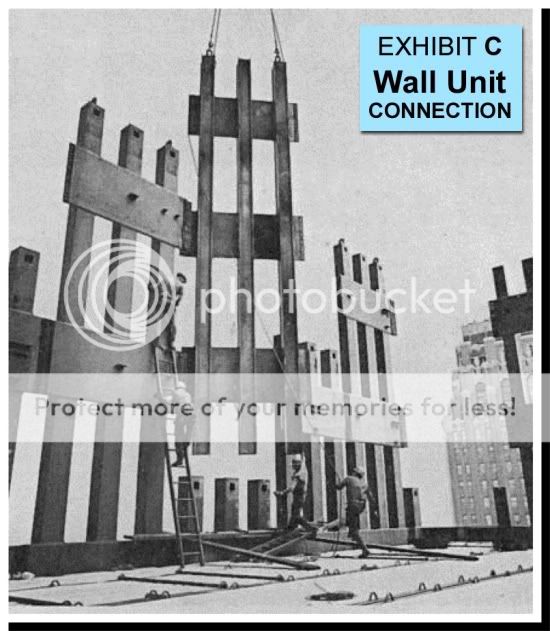
How do you explain those huge 4 ton pieces of structural steel arcing up and out and down on neighboring buildings 600 feet away? That one big piece of still connected wall sections must weigh 60 tons or more. That big piece landed 600 feet away from the North Tower on Winter Garden and WFC3.
GRAVITY? Gravity doesn't push heavy objects up away from the earth.
by David S Chandler - Physics-Mathematics Educator - BS-Physics (IPS); MS-Mathematics
Original video
posted by exponent
You are aware that demolition explosives cut columns, rather than displacing them like this?
Damning evidence of demolition

This was a military demolition of the towers for maximum Shock & Awe effect. This was no ordinary demolition at minimum expense attempting to minimize damage to surrounding buildings. This military demolition of the towers did not take into consideration the people and firefighters trapped in the towers. They were all expendable for the plans of the 9-11 perps and you are desperately trying to defend them. They were pulverized with all that concrete in midair by the explosives which was shredding the massive core structure; and you know it.
How do you know what manner of explosives were used or even where they were placed? The fact is we can see those heavy steel outer walls being blown up and out and down on neighboring buildings 600 feet away. The evidence is right before us and all you can do is deny deny deny.

[edit on 11/10/08 by SPreston]
Great videos, Dora and I were just walking by and stumble on the videos. I am convinced we are looking at explosion, not only is everything been
blasted outward but notices the concrete is vaporizing in mid air. When the top of the building falls sideways those upper floors should have stay
intact, however it just vaporized as it blasted outward away from the building. Yep! It’s an inside job, no question about it. Next question is who
planted the bombs and who working at the WTC aloud them to do it? Could it have been William Rodriguez that help I do not know but I am sure he made
a lot of money telling his story and flying over sea to talk about 911. It’s almost as if he was rewarded for doing his part.
We will always wonder, and that is because people have to tell lies, for what ever they can gain. Come on Dora! Lets go have some treats and chew on this for awhile.
[edit on 11/10/2008 by cashlink]
We will always wonder, and that is because people have to tell lies, for what ever they can gain. Come on Dora! Lets go have some treats and chew on this for awhile.
[edit on 11/10/2008 by cashlink]
cashlink/preston...
Yup, its very sad, but unfortunately true....some military type demolition...
Lets look at the concrete of the two towers....it was turned to dust....DUST.....
How??
I have no idea...but it happened...remember the fine white powder we saw all over NY???
Unexplainable doesnt mean it aint so....because although unexplainable,it happened.
After a building collapses it looks like this...
see the concrete still intact ??
Of course, the above photos were caused by earthquakes...
i dont have any photos of steel framed hi rise buildings being totally collapsed and reduced to rubble ( as in the 47 storey wtc7) which was caused by fire because there are none....
yes folks, the first and only EVER hi rise steel structure collapsing at nearly freefall speed, as a result of a few fires burning on a couple of floors...
No matter what you read here, no matter what the disinfo characters say,that is FACT.
So, for nearly 100 years mankind has been able to build massive multistorey steel framed buildings and NONE ever fell down due to fire..not one...until 9/11 that is, when 3 came down....2 after planes flew into them, and the other, and more intruiging suspicious building WTC7...
See the pics below...??
That building in Madrid, 106 m high burned for over 20 hours, yet the crane remained atop of the structure, and it never collapsed....800Celcius for 20 hours, never fell...
WTC2...56 minutes after impact it fell...
Yet the fires in wtc2(and wtc1) were of such low intensity that people were able to stand in the exact spot where the plane hit, even leaning on the metal beams, which indicates their really was no discernable heat to talk of...
Remember folks...
The official word is that fires caused the collapse of WTC1 and 2....yet you can see for yourself this doesnt make sense....hmmmm!!Confusing!!
One things for sure....on 9/11 2001 the IMPOSSIBLE became REALITY....
Ow, and in closing....what caused this molten metal found in the basements of the towers weeks after 9/11...WTF??molten metal...!!
No one can explain the weird goings on that day and in the weeks afterwards....just to many things not fitting together/ making any sense/ defying logical thought...
...then add the aforementioned disinfo agents spouting the "official version of events"(which are clearly BS)....
No wonder people who havent researched 9/11 are unsure what to think...
afterall BS baffles....doesnt it seymour??
Sorry..having problems with images...new to all this...sorry.
[edit on 10-11-2008 by benoni]
[edit on 10-11-2008 by benoni]
Yup, its very sad, but unfortunately true....some military type demolition...
Lets look at the concrete of the two towers....it was turned to dust....DUST.....
How??
I have no idea...but it happened...remember the fine white powder we saw all over NY???
Unexplainable doesnt mean it aint so....because although unexplainable,it happened.
After a building collapses it looks like this...
see the concrete still intact ??
Of course, the above photos were caused by earthquakes...
i dont have any photos of steel framed hi rise buildings being totally collapsed and reduced to rubble ( as in the 47 storey wtc7) which was caused by fire because there are none....
yes folks, the first and only EVER hi rise steel structure collapsing at nearly freefall speed, as a result of a few fires burning on a couple of floors...
No matter what you read here, no matter what the disinfo characters say,that is FACT.
So, for nearly 100 years mankind has been able to build massive multistorey steel framed buildings and NONE ever fell down due to fire..not one...until 9/11 that is, when 3 came down....2 after planes flew into them, and the other, and more intruiging suspicious building WTC7...
See the pics below...??
That building in Madrid, 106 m high burned for over 20 hours, yet the crane remained atop of the structure, and it never collapsed....800Celcius for 20 hours, never fell...
WTC2...56 minutes after impact it fell...
Yet the fires in wtc2(and wtc1) were of such low intensity that people were able to stand in the exact spot where the plane hit, even leaning on the metal beams, which indicates their really was no discernable heat to talk of...
Remember folks...
The official word is that fires caused the collapse of WTC1 and 2....yet you can see for yourself this doesnt make sense....hmmmm!!Confusing!!
One things for sure....on 9/11 2001 the IMPOSSIBLE became REALITY....
Ow, and in closing....what caused this molten metal found in the basements of the towers weeks after 9/11...WTF??molten metal...!!
No one can explain the weird goings on that day and in the weeks afterwards....just to many things not fitting together/ making any sense/ defying logical thought...
...then add the aforementioned disinfo agents spouting the "official version of events"(which are clearly BS)....
No wonder people who havent researched 9/11 are unsure what to think...
afterall BS baffles....doesnt it seymour??
Sorry..having problems with images...new to all this...sorry.
[edit on 10-11-2008 by benoni]
[edit on 10-11-2008 by benoni]
Originally posted by benoni
After a building collapses it looks like this...
see the concrete still intact ??
Of course, the above photos were caused by earthquakes...
Yes indeed. The gravity collapse building doesn't get pulverized up in mid-air, looking like a pyroclastic flow.
Google Video Link |
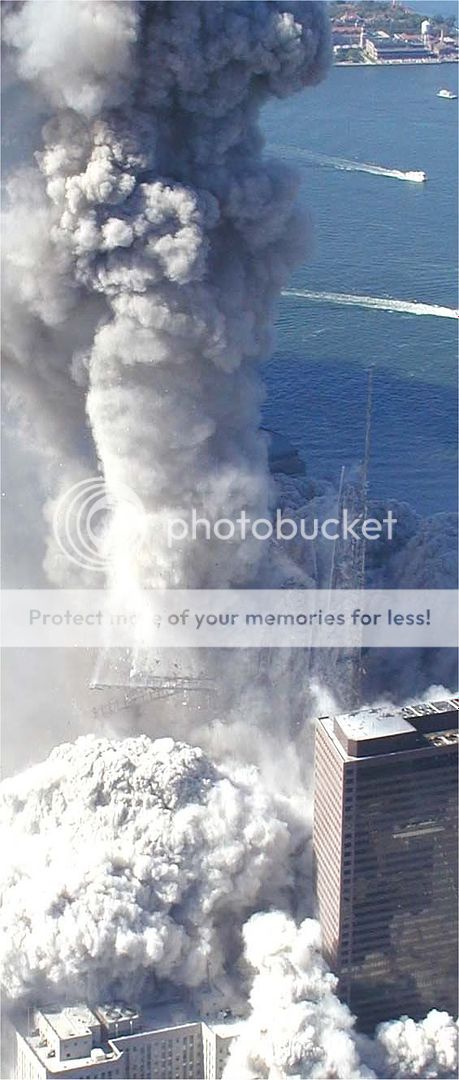
[edit on 11/10/08 by SPreston]
new topics
-
Democrats send letter to Biden urging him to ratify Equal Rights Amendment
US Political Madness: 3 hours ago
top topics
-
Reprehensible Behavior
US Political Madness: 15 hours ago, 11 flags -
This is adorable you guys!
General Chit Chat: 14 hours ago, 8 flags -
Defending the need for adherence to Old Testament commandments under the new covenant of Christ
Conspiracies in Religions: 16 hours ago, 5 flags -
Democrats send letter to Biden urging him to ratify Equal Rights Amendment
US Political Madness: 3 hours ago, 1 flags
active topics
-
Defending the need for adherence to Old Testament commandments under the new covenant of Christ
Conspiracies in Religions • 25 • : nugget1 -
Rant. I am sick of people saying the police are revenue raising.
Rant • 13 • : PorkChop96 -
Only two Navy destroyers currently operational as fleet size hits record low
Military Projects • 23 • : Bluntone22 -
Light from Space Might Be Travelling Instantaneously
Space Exploration • 28 • : Lazy88 -
More Bad News for Labour and Rachel Reeves Stole Christmas from Working Families
Regional Politics • 9 • : covent -
Democrats send letter to Biden urging him to ratify Equal Rights Amendment
US Political Madness • 2 • : VariedcodeSole -
Post A Funny (T&C Friendly) Pic Part IV: The LOL awakens!
General Chit Chat • 7914 • : Cymru -
George Stephanopoulos and ABC agree to pay $15 million to settle Trump defamation suit
Mainstream News • 25 • : Echo007 -
-@TH3WH17ERABB17- -Q- ---TIME TO SHOW THE WORLD--- -Part- --44--
Dissecting Disinformation • 3713 • : 777Vader -
Reprehensible Behavior
US Political Madness • 10 • : nugget1

